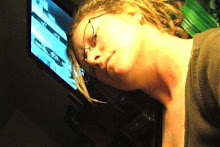Wednesday, January 27, 2010
Lead Shoes-Sidney Peterson
Monday, January 25, 2010
1. What are some characteristics of the American psychodrama in the 1940s?
The films are dreamlike, introspective, and have fluid linear space. The filmmaker plays the protagonist, they acts in their own film, a form of self-realization and inward exploration. The quest for sexual identity is central in psychodramas.
2. What does Sitney mean by an “imagist” structure replacing narrative structure in Choreography for the Camera?
Imagist structure isolates a single gesture as a complete film form, reflective of imagist poetry. It moves away from narrative film structure (not simple story telling), ex. Meshes, Un Chien Andalou, abstract and trance films that have narrative structure.
3. According to Sitney, Ritual in Transfigured Time represents a transition between the psychodrama and what kind of film? Architectonic, mythopoetic
4. Respond briefly to Sitney’s reading of Ritual in Transfigured Time (27-28); Is his interpretation compatible with your experience of the film?
Sitney understands the roles of the women such as invoker, guide and widow and their metamorphosis where as I did not. I did however notice the geometric patterns of movement and repetition. I observed, like Sitney, the correlation of movement and time, and the patterns of three.
Sitney, “The Magus”
5. Paraphrase the paragraph on p. 90 that begins “The filmic dream constituted…” in your own words.
Using the dream metaphor, the camera becomes subjective in relation to the objects in front of it. The camera is the eye but it is being subverted by the film maker, manipulating the objective nature of the camera itself. In a dream you are both an observer and creator.
6. According to Sitney, what is the ultimate result at the end of Inauguration of the Pleasure Dome?
The ritual of the characters becoming gods reflects the subjective nature of The Magus becoming self-aware. The multiplicity and conflicting nature of an individual’s perception of ideas are unified.
Scott MacDonald, “Cinema 16: Introduction”
7. What were some general tendencies in the programming at Cinema 16, and how were films arranged within individual programs?
The focus was variety, and exhibiting films that were educational and enjoyable. Abstract, documentary, avant-garde, educational and scientific. Films were arranged within programs to inspire artistic expressions or provoke thought.
8. What kinds of venues rented Kenneth Anger’s Fireworks?
Membership societies, universities, those free from censorship.
9. What impact did Cinema 16 have on New York City film culture?
It united artists, creating a since of community and inspired and encouraged artist to experiment and create. A model for independent cinema, now artist had a venue in which to show thier work
Hans Richter, “A History of the Avantgarde”
10. What conditions in Europe made the avant-garde film movement possible after World War I?
Political and economic unrest, opposition against conventional film, European art movement, cubism, abstract, expressionism.
11. If the goal of Impressionist art is “Nature Interpreted by Temperament,” what are the goals of abstract art?
Abstract art moves away from the norms and deconstructs objects to their form, taking it further than the cubist it represents only itself and the aesthetics of form.


